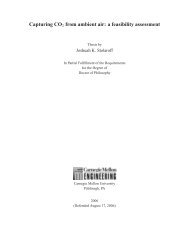Royal Society - David Keith
Royal Society - David Keith
Royal Society - David Keith
Create successful ePaper yourself
Turn your PDF publications into a flip-book with our unique Google optimized e-Paper software.
Recommendation 5<br />
The <strong>Royal</strong> <strong>Society</strong>, in collaboration with other appropriate<br />
bodies, should initiate a process of dialogue and<br />
engage ment to explore public and civil society attitudes,<br />
concerns and uncertainties about geoengineering as<br />
a response to climate change. This should be designed<br />
so as to:<br />
a) Clarify the impact that discussion of the possible<br />
implementation of geoengineering may have on<br />
general attitudes to climate change, adaptation<br />
and mitigation;<br />
b) Capture information on the importance of various<br />
factors affecting public attitudes, including: novelty/<br />
familiarity, scale of application and effect, aesthetics,<br />
the actors involved, centralisation of control, contained<br />
versus dispersed methods and impacts, and the<br />
reversibility of effects;<br />
c) Provide participants with objective information as<br />
to the potential role of geoengineering within the<br />
broader context of climate change policies, the<br />
differences between CDR and SRM methods, and<br />
their relative risks and benefits.<br />
6.6 Governance<br />
The governance issues associated with geoengineering,<br />
and especially with SRM and ecosystem-based CDR<br />
methods are substantial and serious. As with climate<br />
change, there will be winners and losers associated with<br />
the implementation of geoengineering methods. The<br />
potential benefits and risks to society will need to be<br />
identified and assessed as part of any process to establish<br />
new, or modify existing, geoengineering governance<br />
mechanisms. Tools for international monitoring, verification<br />
and certification will also be required.<br />
There are at present no international treaties or institutions<br />
with a sufficiently broad mandate to regulate the broad<br />
range of possible geoengineering activities and there is a<br />
risk that methods could be applied by individual nation<br />
states, corporations or one or more wealthy individuals,<br />
without concern for their transboundary implications.<br />
Mechanisms by which deployment (and where necessary,<br />
research) can be controlled and regulated are therefore<br />
necessary. Some methods could be effectively governed<br />
and managed by employing or amending existing treaties<br />
and protocols of international law where activities have<br />
cross border implications, and under national regulations<br />
where activities and their impacts are confined within<br />
national boundaries. However, others (such as atmosphere<br />
and space-based methods) may require new international<br />
mechanisms.<br />
Appropriate governance mechanisms for regulating the<br />
deployment of geoengineering methods should be<br />
established before they are needed in practice, and these<br />
mechanisms should be developed in the near future if<br />
geoengineering is to be considered as a potential option<br />
for mitigating climate change. They should allow for the<br />
international control and governance requirements of<br />
large-scale methods, and the local or national regulation<br />
of contained methods.<br />
Financial incentives will need to be established for if and<br />
when deployment is necessary. This may require the<br />
valuation of reductions of radiative forcing and of<br />
atmospheric CO 2 removal, the creation of new and future<br />
extension of, existing mechanisms such as carbon trading<br />
schemes and the Clean Development Mechanism.<br />
However, it is concluded that it would for the time being be<br />
premature to create financial incentives for activities other<br />
than those that involve the long-term sequestration of<br />
verifiable quantities of carbon.<br />
Some people object to deliberate manipulation of natural<br />
systems (although it has long been associated with human<br />
development), and this may in some cases also extend to<br />
undertaking research (especially field trials) involving<br />
environmental interventions. In some cases (eg sulphate<br />
aerosols) it is also not clear that field trials can easily be<br />
conducted on a limited scale, or without appreciable and<br />
widespread environmental impacts. The development of<br />
an internationally agreed code of conduct and system of<br />
approval for R&D would have the benefit of increasing<br />
the transparency with which geoengineering related<br />
research is undertaken and could contribute to building<br />
public confidence in this field. Scientists from across the<br />
public and private sectors should be invited to collaborate<br />
in the process.<br />
It would be highly undesirable for geoengineering methods<br />
which involve activities or effects (other than simply the<br />
removal of greenhouse gases from the atmosphere) that<br />
extend beyond national boundaries to be subject to large<br />
scale research or deployment before appropriate<br />
governance mechanisms are in place.<br />
Recommendation 6<br />
6.1 The governance challenges posed by geoengineering<br />
should be explored in more detail, and policy<br />
processes established to resolve them.<br />
6.2 An international body such as The UN Commission<br />
for Sustainable Development should commission a<br />
review of international and regional mechanisms to:<br />
a) Consider the roles of the following bodies:<br />
UNCLOS, LC/LP, CBD, CLRTAP, Montreal<br />
Protocol, Outer Space Treaty, Moon Treaty,<br />
UNFCCC/KP, ENMOD.<br />
b) Identify existing mechanisms that could be used<br />
to regulate geoengineering research and<br />
deployment activities.<br />
c) Identify where regulatory gaps exist in relation to<br />
geoengineering methods proposed to date.<br />
d) Establish a process for the development of<br />
mechanisms to address these gaps.<br />
60 I September 2009 I Geoengineering the Climate The <strong>Royal</strong> <strong>Society</strong>








